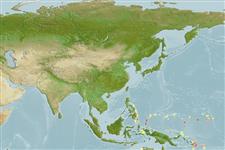>
Gobiiformes (Gobies) >
Gobiidae (Gobies) > Gobiinae
Etymology: Trimma: Greek, trimma, -atos = something crushed (Ref. 45335); hamartium: Name from the Greek word 'hamartia' (ἁμαρτία) m alluding to the author’s error in not recognizing the differences between this species and T. preclarum when describing the latter (the term encompasses 'wrongdoings' which may be either accidental or deliberate).
Environment: milieu / climate zone / intervalo de profundidade / distribution range
Ecologia
marinhas associadas(os) a recifes; intervalo de profundidade 7 - 50 m (Ref. 116838). Tropical
Distribuição
Países | Áreas FAO | Ecossistemas | Ocorrências | Mapa dos pontos | Introduções | Faunafri
Western Pacific: southwest Palau and probably true for Fiji (paratypes of T. preclarum), Niue, Solomon Is., Indonesia (Mapia Atoll), Australia (GBR) and Kiribati (Abaiang Atoll).
Tamanho / Peso / Idade
Maturidade: Lm ? range ? - ? cm
Max length : 2.5 cm SL macho/indeterminado; (Ref. 116838)
Descrição breve
Chaves de identificação | Morfologia | Morfometria
Espinhos dorsais (total) : 7; Raios dorsais moles (total) : 9; Espinhos anais: 1; Raios anais moles: 8 - 9. This species is distinguished by the following characters: no scales on the cheeks and opercle; 8-9 scales in predorsal midline; short second dorsal spine reaching to a mean of the base of the first ray of the second dorsal fin when abducted; pectoral-fin rays 17-19 with 5-10 branched rays in the middle of the fin; an unbranched 5th pelvic-fin ray, 51-64% the length of 4th ray; total gill rakers 17-19; papillae in row c 6, below the eye; U-shaped bony interorbital with a narrow slit-like postorbital trench which ends at the posteriormost papilla in row p; colour when freshly collected, a reddish head with 3-4 yellow bars on the cheek, red iris with four yellow spots, yellow body which is lighter posteriorly, scales pockets outlined with melanophores and scale rows above and below midlateral row much lighter posterior to second dorsal fin origin (giving appearance of three yellow stripes on body); colour when preserved with fairly evenly distributed melanophores over the dorsal surface of the snout (Ref. 116838).
Body shape (shape guide): elongated; Cross section: oval.
Found in areas with heavy cover of hard corals (Acropora, Pocillopora, Millepora, plate corals, lettuce corals star and cactus corals), variety of sponges, sea whips, ascidians, alcyonarians, tunicates, hydoids (in caves), soft corals, gorgonians, brown encrusting algae; and also on steep reef slopes and almost vertical walls with several large caves with sand/rubble floors, undercuts and small platforms (Ref. 116838).
Life cycle and mating behavior
Maturidade | Reprodução | Desova | Ovos | Fecundidade | Larvas
Winterbottom, R., 2018. A new species of Trimma (Pisces; Gobiidae) from the South-West Islands of Palau, western Pacific Ocean. Zootaxa 4370(2):123-136. (Ref. 116838)
Categoria na Lista Vermelha da IUCN (Ref. 130435: Version 2025-1)
Ameaça para o homem
Harmless
Utilização humana
Pescarias: sem interesse
Ferramentas
Relatórios especiais
Descarregue XML
Fontes da internet
Estimates based on models
Phylogenetic diversity index (Ref.
82804): PD
50 = 0.5000 [Uniqueness, from 0.5 = low to 2.0 = high].
Bayesian length-weight: a=0.00724 (0.00339 - 0.01546), b=3.10 (2.92 - 3.28), in cm total length, based on LWR estimates for this (Sub)family-body shape (Ref.
93245).
Resiliência (Ref.
120179): Elevada, tempo mínimo de duplicação da população menor que 15 meses (Preliminary K or Fecundity.).
Fishing Vulnerability (Ref.
59153): Low vulnerability (10 of 100).
🛈
